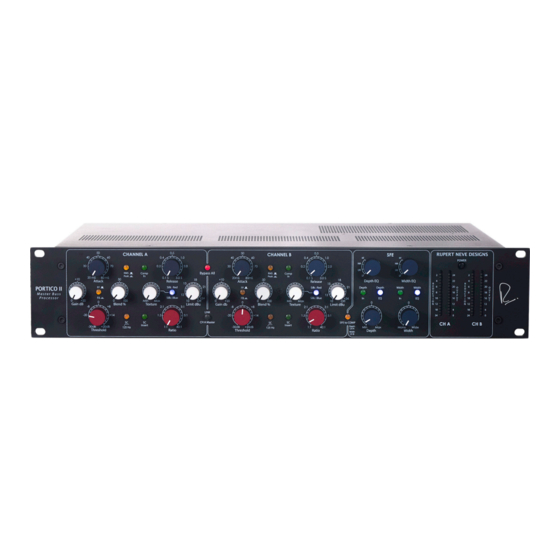Table of Contents
Advertisement
Quick Links
Advertisement
Table of Contents

Subscribe to Our Youtube Channel
Summary of Contents for Rupert Neve Designs Portico II
- Page 1 Portico II Master Buss Processor Serial #: Operations Manual...
- Page 2 Thank you for your purchase of a Portico II Master Buss Processor. Everyone at Rupert Neve Designs hope you enjoy using this tool as much as we have enjoyed designing and building it. The name “Portico II” is being used for a series of new ultra-high end professional products that will share some traits.
- Page 3 your safety. Unplug the module during lightning storms or when unused for long periods of time. Don’t operate your Portico II module in or around water! Electronic equipment and liquids are not good friends. If any liquid is spilled, such as soda, coffee, alcoholic or other drink, the sugars and acids will have a very detrimental effect.
- Page 4 Portico II Master Buss Processor: Front / Back Panel...
-
Page 6: Power Requirements
The Rupert Neve Designs Portico II™ Channel Overview The Rupert Neve Designs Portico II Master Buss Processor (MBP) is a full 19” rack width, 3.5” (2U) with standard rack mounting “ears”. As with the entire Portico II range, the construction incorporates a heavy and robust steel shell that provides total magnetic screening and exceptional mechanical stability. - Page 7 Freedom from the interference fields that are inevitably present in any control room is virtually guaranteed by the balanced, ground-free design used in the MBP. The classic Rupert Neve designed modules always used transformers, as do a number of other high quality vintage modules still in current use.
- Page 8 listener’s electroencephalo-grams. Kunchur describes several demonstrations that have shown that our hearing is capable of approximately twice the timing resolution than a limit of 20 kHz might imply (F=1/T or T=1/F). His peer reviewed papers demonstrated that we can hear timing resolution at approximately with 5 microsecond resolution (20 kHz implies a 9 microsecond temporal resolution, while a CD at 44.1k sample rate has a best-case temporal resolution of 23 microseconds).
-
Page 9: Compressor-Limiter Controls
Sound Perception” Paper read at 91st. Convention of the A.E.S.October 1991. Section 7. (1), Conclusion. 2. Miland Kunchur,Depart of Physics and Astronomy, University of South Carolina. “Temporal resolution of hearing probed by bandwidth restriction”, M. N. Kunchur, Acta Acustica united with Acustica 94, 594–603 (2008) (http://www.physics. sc.edu/kunchur/Acoustics-papers.htm) 3. - Page 10 sections, either of which suggest maybe too much compressor “action”. Conversely, losing quiet phrases or inadvertent clipping might suggest that a little more compression is warranted, keeping in mind that you can always do a bit more in the mix but undoing over-compression is not fun and often not even possible.
- Page 11 referred to as “the side-chain”. Note that the rest of the circuit and output will not have those lows filtered out. This function tends to be very useful because typical sounds often have more energy in the low octaves and can cause excessive compression. Our ears may tend to associate loudness with mids or high mids for some sounds and one may be wanting the compressor to regulate and smooth perceived loudness.
- Page 12 the “knee” when the threshold knob is set quite high. Both the limiter and soft clipper are switched out of circuit with the knob is fully clockwise. The release times are fully automatic and adjust depending both on the average depth of limiting and the duration of the transients above the threshold. The limiters share the same discrete, class-A gain module and VCA with the compressors, so using the Limiter does not introduce more stages that the music would have to pass through.
-
Page 13: Gain Reduction Meter
ambience and dimension. WIDTH & DEPTH EQ To fine tune the SFE, there are individual filters that allow a fine tuning of what information is reintroduced from the width and depth circuits, thus tailoring each effect to a specific bandwidth. For example, if one wanted to increase the amount of low frequencies in the center image, engaging the SFE Depth and Depth EQ, set to LF, would filter out everything in the Mid signal except what is below the filter point (in this case, 250 Hz), and once reintroduced to the original would result in a perceived... -
Page 14: Specifications
Specifications Frequency Response: Main Output, no load, –3 dB @ 2 Hz –3 dB @ 160 kHz Maximum Output Level: Maximum output from 20 Hz to 40 kHz is +25 dBu. Total Harmonic Distortion and Noise: @ 1kHz, +20 dBu output: Better than 0.002% As above, Silk Engaged: Better than 0.2% Second Harmonic @ 20Hz, +20 dBu out... - Page 15 SFE Depth EQ Curves +17.5 +12.5 +7.5 +2.5 -2.5 -7.5 -12.5 -17.5 100k Blue Cyan Green Yellow No EQ EQ setting 1 EQ Setting 2 EQ Setting 3 EQ Setting 4 SFE Width EQ Curves 100k Blue Cyan Green Yellow No EQ EQ setting 1 EQ Setting 2...
-
Page 17: Product Warranty
PRODUCT WARRANTY Rupert Neve Designs warrants this product to be free from defects in materials and workmanship for a period of one (1) year from date of purchase, and agrees to remedy any defect identified within such one year period by, at our option, repairing or replacing the product.



Need help?
Do you have a question about the Portico II and is the answer not in the manual?
Questions and answers